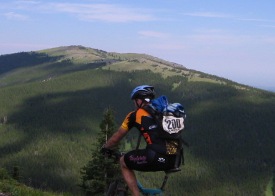
Tales of the One-Legged Wolf
Despite having only one leg to ride with, Brett Wolf completes his 3rd TransRockies...
February 26, 2005

|
| Brett and his bionic leg Photo by Garry Edmundson |
Having lost his right leg in a motorcycle accident in 1990, he competes in these events against two-leggers and routinely finishes ahead of 25-30% of them.
A lifelong athlete, Brett shifted his talent and energy from back-country alpine skiing to mountain bike racing only less than two years after his above the knee amputation. He entered his first race and finished last. Though initially disappointed in his performance, when he learned that many had not even finished, Brett was hooked. What makes Brett stand out above all is his unwavering passion and positive spirit: it is difficult for fellow competitors to feel too badly when he passes them going uphill on the course when he always has a kind word of encouragement for each one.
What follows is Brett Wolfeís account of his most recent race across the Canadian Rockies. But first, a bit on how he races on just one leg...
Mechanics of racing with one leg and the Wolfís body
MountainZone asked me to talk about riding with one leg versus two and the challenges. Rather than write a novel and with minutia of detail to guide someone on the journey....Iíll keep it simple. Hopefully it will not sound like whining - something I detest. I truly enjoy the ability to ride a bike in the mountains. Many times bounding through the single track I honestly donít feel as if I have physical disadvantages. Obviously, racing with one leg does have some disadvantages, but in traditional dry humor of my family you have to see the positive side.
A. Missing a lower leg means less power and definitely less torque and uneven torque surge to the rear wheel. Good news is you drop 15lbs of weight, and therefore have lighter overall weight for climbing. More good news is to keep spinning I have more gears, lower ones I might add...32 to be exact, than my competitors. More is better.
B. Hard to stand and pedal. While your butt may hurt more, the good news is you can sit on your butt cheek rather than in the middle, crushing the soft tissue and ruining your chances of having children or needing a funky shaped seat.
D. The bike becomes a crutch. With an above knee amputation, you have no hamstring or quad. The power gain from bringing a prosthetic leg on a trip is negligible. (Plus you gain back that weight you lost.) Therefore, your bike becomes your crutch. Lock the brakes and maneuver. No extra stuff makes you travel lighter, Zen-like and faster. Plus bearing manufactures get to see how their stuff works being submerged 100% of the time.
E. Miscellaneous stuff: Lack of ligament in remaining joints, knee, shoulders and elbows. Good news is if you overextend the joint, you have very little to tear, therefore recovery can be significantly faster. With the sciatic nerve damage in my left leg, I donít feel as much of the pesky cold and minor pains and aches. My shortened Achilles and semi-fused ankle make it hard to overextend while hiking for long periods.
Most importantly, if walking is not a good option (slow and hard on your remaining foot) you are obligated to ride more terrain challenges, becoming a more accomplished technical rider by default.